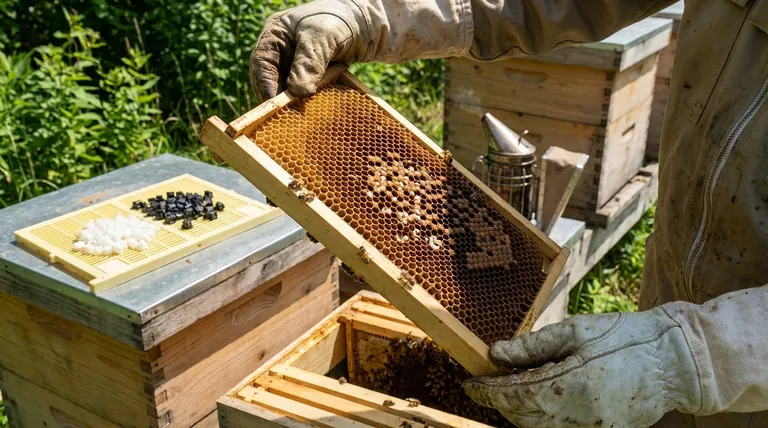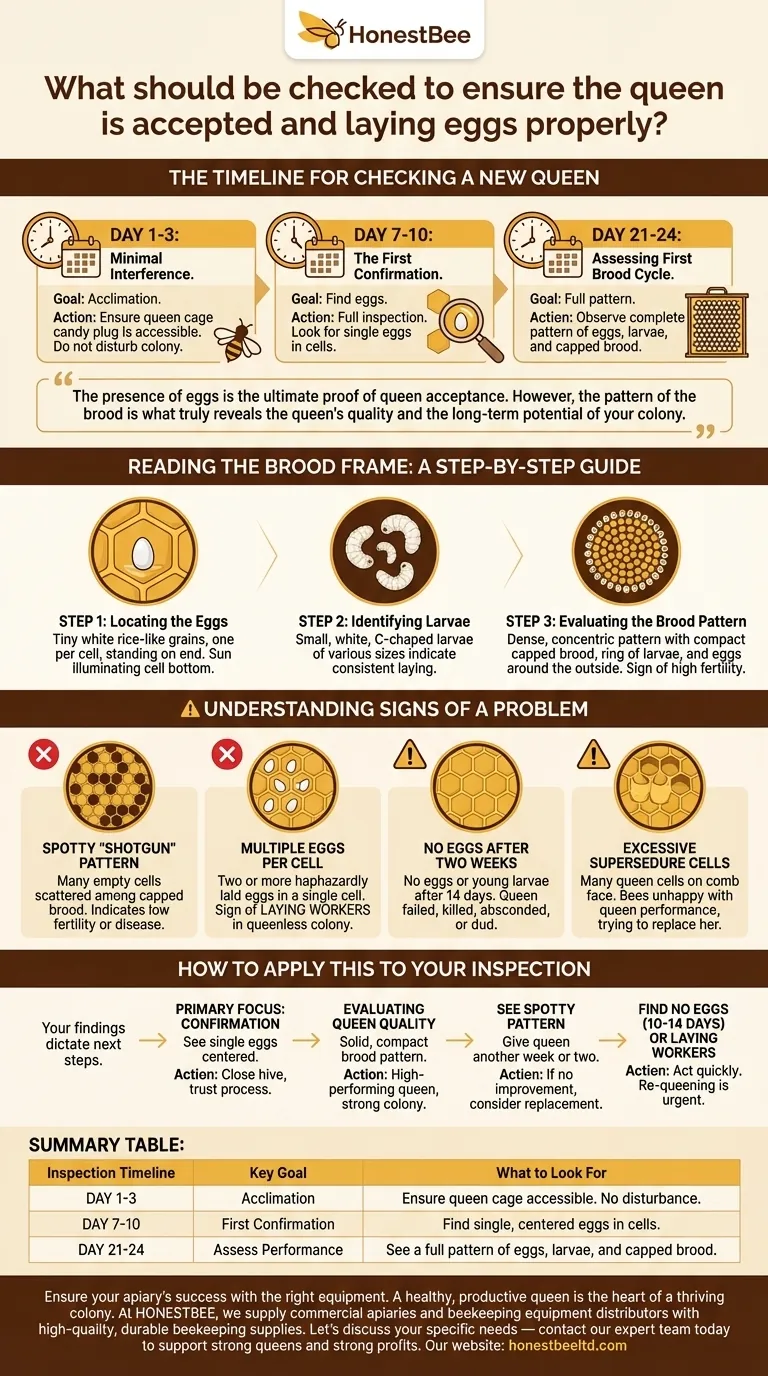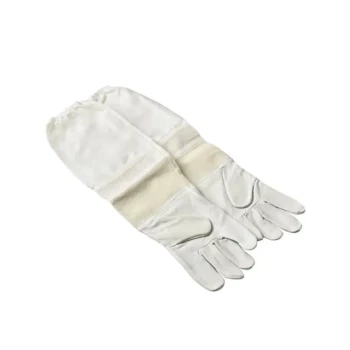To confirm a new queen is accepted and laying properly, you must visually inspect the brood frames. The definitive signs are the presence of tiny, rice-like eggs—one per cell—and a growing pattern of larvae and capped brood. These observations confirm the colony has accepted her and she has begun her essential work.
The presence of eggs is the ultimate proof of queen acceptance. However, the pattern of the brood is what truly reveals the queen's quality and the long-term potential of your colony.

The Timeline for Checking a New Queen
Patience is a beekeeper's most critical tool after introducing a new queen. Opening the hive too early can disrupt the acceptance process and cause the bees to reject or harm her.
Day 1-3: Minimal Interference
Your only task is to ensure the queen cage's candy plug is accessible to the bees. Do not open the hive further or disturb the cluster. The colony needs this time to acclimate to her pheromones.
Day 7-10: The First Confirmation
This is the ideal time for your first full inspection after introduction. By now, the queen should have been released by the workers, mated (if she was a virgin queen), and started laying. Your primary goal is to find evidence of eggs.
Day 21-24: Assessing the First Brood Cycle
Roughly three weeks after the first eggs are laid, you should see the first of her offspring emerging as adult bees. You will also see a complete pattern of eggs, larvae, and capped brood, giving you a full picture of her performance.
Reading the Brood Frame: A Step-by-Step Guide
The brood frame tells a story. Learning to read it correctly allows you to understand the health and status of your queen and colony.
Step 1: Locating the Eggs
Eggs are the most crucial and often hardest sign to spot. They look like tiny white grains of rice standing on end at the bottom of a cell.
Tilt the frame so the sun illuminates the bottom of the cells. A single egg laid dead-center is the classic signature of a healthy, mated queen.
Step 2: Identifying Larvae
As eggs hatch, they become small, white, C-shaped larvae. You should see larvae of various sizes, indicating the queen has been laying consistently over several days.
The presence of young larvae confirms the queen was laying at least three to five days prior to your inspection.
Step 3: Evaluating the Brood Pattern
The brood pattern is the most important indicator of a queen's quality. In a healthy hive, the queen lays eggs in a dense, concentric pattern.
A strong queen will create a solid, compact area of capped brood, often with a ring of larvae and then eggs around the outside. This is a sign of high fertility and good colony growth.
Understanding Signs of a Problem
Not every queen introduction is successful. Recognizing the warning signs early allows you to take corrective action before the colony becomes unrecoverable.
A Spotty or "Shotgun" Brood Pattern
If you see a brood pattern with many empty cells scattered among capped brood, this is a "shotgun" pattern. It can indicate an old or poorly mated queen with low fertility, or potential brood diseases.
Multiple Eggs Per Cell
If you see two, three, or more eggs haphazardly laid in a single cell, this is a definitive sign of laying workers. This occurs in a hopelessly queenless colony where worker bees' ovaries have activated.
No Eggs After Two Weeks
If a full 14 days have passed since introduction and you find no eggs or young larvae, the queen has failed. She may have been killed, absconded, or is simply a "dud" who is unable to lay.
Excessive Supersedure Cells
Finding one or two supersedure cells (queen cells typically built on the face of the comb) can be normal. However, if you find many, it's a sign the bees are unhappy with the queen's performance and are actively trying to replace her.
How to Apply This to Your Inspection
Your findings during the inspection will dictate your next steps.
- If your primary focus is confirmation: Seeing single eggs centered in their cells is your goal. Once you see eggs, close the hive and trust the process.
- If you are evaluating queen quality: A solid, compact brood pattern across several frames is the sign of a high-performing queen who will build a strong colony.
- If you see a spotty pattern: Give the queen another week or two, especially if she is new. If the pattern doesn't improve, you may need to consider replacing her.
- If you find no eggs after 10-14 days or see signs of laying workers: You must act quickly. Re-queening the hive is urgent to prevent the colony's collapse.
Trusting your observations is the key to successful colony management.
Summary Table:
| Inspection Timeline | Key Goal | What to Look For |
|---|---|---|
| Day 1-3 | Acclimation | Ensure queen cage is accessible. No disturbance. |
| Day 7-10 | First Confirmation | Find single, centered eggs in cells. |
| Day 21-24 | Assess Performance | See a full pattern of eggs, larvae, and capped brood. |
Ensure your apiary's success with the right equipment. A healthy, productive queen is the heart of a thriving colony, and her success depends on a well-managed hive. At HONESTBEE, we supply commercial apiaries and beekeeping equipment distributors with high-quality, durable beekeeping supplies through our wholesale-focused operations. From hive tools for gentle inspections to protective gear and essential hive components, we provide the reliable foundation your beekeeping business needs to grow. Let's discuss your specific needs — contact our expert team today to get the wholesale supplies that support strong queens and strong profits.
Visual Guide

Related Products
- No Grafting Queen Rearing Kit: System for Royal Jelly Production and Queen Rearing
- Plastic Chinese Queen Grafting Tool for Bee Queen Rearing
- JZBZ Push-In Queen Cell Cups for Beekeeping
- Brown Nicot Queen Cell Cups for Breeding Queen Bees Beekeeping
- HONESTBEE Advanced Ergonomic Stainless Steel Hive Tool for Beekeeping
People Also Ask
- What is the timeline for queen breeding? A 28-Day Guide from Egg to Laying Queen
- What are the developmental periods for different bee castes? Master the 16, 21, and 24-Day Timelines for Hive Success
- How can beekeepers start a honey bee breeding program? Build a Superior, Resilient Apiary
- What should be done once eggs are present in the comb box? A Guide to Maximizing Queen Rearing Success
- What is requeening, and why is it performed? Take Control of Your Hive's Health and Productivity



















